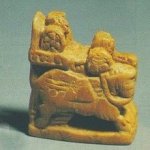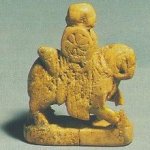Chatrang / Chaturanga, a Chess ancestor
Chess sprung from nowhere in the beginning of the 7th century AD in Sassanian Persia. In these times, the Sassanid kings ruled an empire comprising modern Iran and also Iraq, Afghanistan and most of Central Asia. From Afrasiab, near Samarkand, comes the oldest extant Chess set. In the first half of that 7th century, there are 3 texts written in Pahlavi (Middle Persian) which evokes Chatrang, the eldest member known of the Chess family.
From those texts, we learn that Chatrang was rather well known and estimated at the Persian court and, also, that the game had come with the ambassade of an Indian king. In fact, a contemporary Sanskrit text indicates that Chess, there named Chaturanga, was known in the kingdom of Harsha of Kannauj, in the Ganges valley. The same Indian city might be, with some probability, the Kingdom which sent the game of Chess to the Persian court.
Are Chatrang and Chaturanga the same
game? It seems that the Pahlavi word "Chatrang" takes its
roots from the Sanskrit word "Chaturanga" which
means "four members". Four members as the four members of
the epic Indian army, infantry, cavalry, elephants and
chariots. In any case, Pahlavi and Sanskrit are two
languages of the same branch of the Indo-European
languages family.
Persian or Indian, both cultures have solid claims and the question remains open. For the moment, let's call it the Indo-Persian Chess game.
In 644, the Muslim armies defeated and conquered Persia. They soon adopted Chatrang. The time of Shatranj has come.

The legend of the invention of Nard at
Persian court as an answer to the arrival of Chess from
India, has been often illustrated in the Muslim world.
DESCRIPTION:
The description is known from a Persian
text which dates from the beginning of the 7th century,
the Wizarishn i chatrang ud nihishm i new-ardaxshir
(The explanation of Chess and the invention of Nard)
. The earliest Indian source describing the rules is from
the 12th century only, the Manasollasa (Joy of the
mind) of Prince Someshvara III.
The board was uniform with 8x8 squares. Each players had 16 pieces : 1 Shah (King), 1 Frazen (General), 2 Pil (Elephant), 2 Asp (Horse), 2 Rox (Chariot, in a sense of "officier on a chariot") and 8 Payadag (Soldiers).
No more details are known. Later, Arabic writers were the first to give the complete rules of their Shatranj. It is supposed that the rules were unchanged from Chatrang to Shatranj, so the reader may look at Shatranj to guess how Chatrang was played, but with no certainty.








